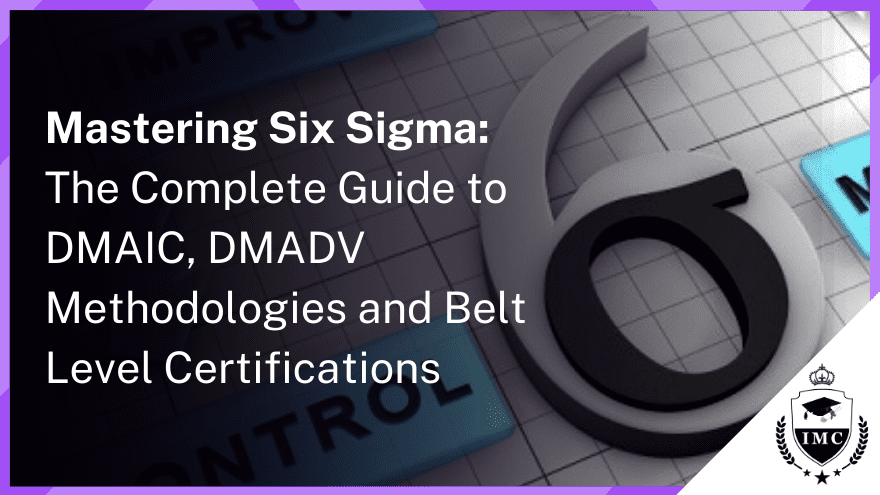Six Sigma has emerged as one of the most influential and widely adopted process excellence approaches used by leading organizations worldwide. At its core are structured methodologies like DMAIC and DMADV that provide practitioners with step-by-step roadmaps to execute improvement projects. In addition, Six Sigma leverages clearly defined team roles denoted by belt levels to ensure the right experts are applying their skills at the right stages. In this comprehensive guide, we will demystify the DMAIC and DMADV methodologies and provide an in-depth look at the various Six Sigma certification levels, from White Belts to Master Black Belts. Understanding these critical components of Six Sigma is essential for practitioners looking to implement improvements or pursue process excellence careers.
DMAIC Methodology
DMAIC serves as the foundation for most Six Sigma process improvement projects. It is an acronym that stands for the five key phases:
Define - Clearly articulate the problem, goal, potential financial benefits, resources needed, and high-level project scope.
Measure - Quantify the current process and identify key metrics to track. Develop a data collection plan.
Analyze - Scrutinize the metrics to determine root causes of defects, variations, or other issues. Identify key drivers using statistical analysis tools.
Improve - Based on analysis, implement targeted solutions to address root causes and optimize the process.
Control - Define systems and procedures to sustain gains and prevent backsliding. Monitor metrics to ensure improvements stick.
DMAIC provides a data-driven approach to incrementally improving and stabilizing existing processes. It aims to reduce variability and defects.
DMADV Methodology
DMADV is used for Six Sigma projects focused on creating new product or process designs rather than improving existing ones. DMADV stands for:
Define - Outline the goals of the design activity and potential benefits. Identify requirements and high-level capabilities.
Measure - Identify characteristics that are Critical to Quality (CTQs). Determine measures for innovation, capabilities, and benefits.
Analyze - Evaluate alternatives. Assess design capability to meet CTQs. Conduct risk analysis of potential options.
Design - Develop a comprehensive process design. Optimize the design while reducing risk of failure.
Verify - Confirm the design satisfies the key requirements through extensive testing and piloting. DMADV enables the creation of optimized and low-risk product, service, or process designs aligned to critical needs.
Six Sigma Belts: Levels of Expertise
Six Sigma expertise is often denoted by belt level certifications.
Key roles include:
White Belts –Understand basic Six Sigma concepts and tools. Help support projects.
Yellow Belts – Learn and apply basic Six Sigma techniques to less complex projects. Assist with data collection and analysis.
Green Belts – Lead smaller scale improvement projects using Six Sigma tools like basic statistical analysis, root cause analysis, and process mapping. Typically have at least 3 years relevant work experience.
Black Belts – Highly proficient experts who lead complex strategic improvement projects with substantial bottom line impact. Master statistical analysis tools like design of experiments and regression. Have at least 3 years of experience.
Master Black Belts – The most experienced and skilled specialists who train and mentor Black Belts and other team members. Have extensive Six Sigma project leadership experience.
Benefits of Implementing Six Sigma:
Improved Efficiency and Productivity: Six Sigma methodologies, particularly DMAIC, help organizations identify and eliminate inefficiencies in their processes. By streamlining workflows and reducing defects, companies can significantly improve overall efficiency and productivity.
Enhanced Customer Satisfaction:
With a focus on meeting customer requirements and minimizing defects, Six Sigma directly contributes to enhanced customer satisfaction. By consistently delivering high-quality products and services, organizations can build trust and loyalty among their customer base.
Cost Reduction:
Six Sigma's emphasis on process optimization leads to cost reduction. By eliminating waste and improving resource utilization, organizations can realize substantial financial benefits, contributing to a healthier bottom line.
Data-Driven Decision Making:
The data-centric approach of Six Sigma ensures that decisions are based on concrete evidence and analysis. This not only enhances the accuracy of decision-making but also fosters a culture of continuous improvement grounded in measurable results.
Organizational Culture of Continuous Improvement:
Six Sigma is not just a set of tools and methodologies; it's a philosophy that promotes a culture of continuous improvement. This cultural shift encourages employees at all levels to actively engage in identifying opportunities for enhancement and contributing to the organization's overall success.
Summary:
In summary, by leveraging proven methodologies like DMAIC and DMADV, supported by a well-defined system of technical expertise through the Six Sigma belt levels, organizations have a proven framework to drive sustained improvements. DMAIC delivers a data-driven approach for incrementally optimizing existing processes. DMADV enables breakthrough new product and process designs optimized for reliability. The belt system then ensures the right mix of statistical analysis skills, process improvement experience, and leadership abilities are applied to make improvements successful. Mastering both the technical and people aspects of Six Sigma is critical for process excellence.






